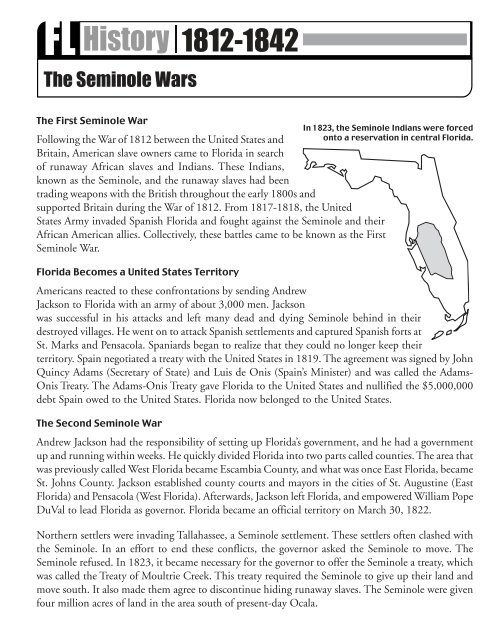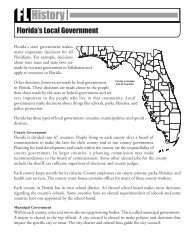Create successful ePaper yourself
Turn your PDF publications into a flip-book with our unique Google optimized e-Paper software.
FL History <strong>1812</strong>-<strong>1842</strong><br />
The Seminole Wars<br />
Early 1800s<br />
The First Seminole War<br />
Following the War of <strong>1812</strong> between the United States and<br />
Britain, American slave owners came to Florida in search<br />
of runaway African slaves and Indians. These Indians,<br />
known as the Seminole, and the runaway slaves had been<br />
trading weapons with the British throughout the early 1800s and<br />
supported Britain during the War of <strong>1812</strong>. From 1817-1818, the United<br />
States Army invaded Spanish Florida and fought against the Seminole and their<br />
African American allies. Collectively, these battles came to be known as the First<br />
Seminole War.<br />
Florida Becomes a United States Territory<br />
Americans reacted to these confrontations by sending Andrew<br />
Jackson to Florida with an army of about 3,000 men. Jackson<br />
was successful in his attacks and left many dead and dying Seminole behind in their<br />
destroyed villages. He went on to attack Spanish settlements and captured Spanish forts at<br />
St. Marks and Pensacola. Spaniards began to realize that they could no longer keep their<br />
territory. Spain negotiated a treaty with the United States in 1819. The agreement was signed by John<br />
Quincy Adams (Secretary of State) and Luis de Onis (Spain’s Minister) and was called the Adams-<br />
Onis Treaty. The Adams-Onis Treaty gave Florida to the United States and nullified the $5,000,000<br />
debt Spain owed to the United States. Florida now belonged to the United States.<br />
The Second Seminole War<br />
In 1823, the Seminole Indians were forced<br />
onto a reservation in central Florida.<br />
Andrew Jackson had the responsibility of setting up Florida’s government, and he had a government<br />
up and running within weeks. He quickly divided Florida into two parts called counties. The area that<br />
was previously called West Florida became Escambia County, and what was once East Florida, became<br />
St. Johns County. Jackson established county courts and mayors in the cities of St. Augustine (East<br />
Florida) and Pensacola (West Florida). Afterwards, Jackson left Florida, and empowered William Pope<br />
DuVal to lead Florida as governor. Florida became an official territory on March 30, 1822.<br />
Northern settlers were invading Tallahassee, a Seminole settlement. These settlers often clashed with<br />
the Seminole. In an effort to end these conflicts, the governor asked the Seminole to move. The<br />
Seminole refused. In 1823, it became necessary for the governor to offer the Seminole a treaty, which<br />
was called the Treaty of Moultrie Creek. This treaty required the Seminole to give up their land and<br />
move south. It also made them agree to discontinue hiding runaway slaves. The Seminole were given<br />
four million acres of land in the area south of present-day Ocala.
<strong>1812</strong>-<strong>1842</strong><br />
This area was called a reservation. This reservation, however, did not suit the needs of the<br />
Seminole. Meanwhile, their former home in Tallahassee, became the new capital of the territory.<br />
In 1829, Andrew Jackson became President of the United States. He worked to have the Indian<br />
Removal Act passed by Congress. It became law in 1830. The purpose of this act was to move all the<br />
Indians to land west of the Mississippi River. The Seminole did not want to leave their Florida home,<br />
but agreed to send some chiefs to look at the new land where they would be relocated. While they were<br />
viewing the land, the chiefs were persuaded to sign a treaty agreeing to move. When they returned<br />
back to Florida, however, they claimed they had been tricked. They refused to leave.<br />
Osceola resisted the Federal<br />
government's plan to relocate<br />
all Native Americans to land<br />
west of the Mississippi.<br />
Florida Becomes the 27th State<br />
A warrior named Osceola led the Seminole in surprise attacks against the<br />
Americans. The first battle of the war was known as the Dade Massacre.<br />
It occurred when Major Dade was leading a combined Army from Fort<br />
Brooke (Tampa) and Fort King (Ocala). In an attack by Osceola and his<br />
men, over a hundred soldiers were killed near what is now Bushnell.<br />
The United States sent many troops into Florida to defeat the Seminole.<br />
They were successful in pushing the Seminole further and further south<br />
into the wilderness. Several agreements were made by Seminole chiefs<br />
to leave the area, but the agreements continually fell through. Finally,<br />
Osceola was captured and he died in prison in 1838. Following his death,<br />
the Seminole began to decline. Many were killed; others were captured<br />
and relocated out west. On August 14, <strong>1842</strong>, The Second Seminole War<br />
officially ended. As a result, many Seminole were sent to reservations in<br />
the west.<br />
Floridians had continued to take steps toward statehood throughout the confrontations with the<br />
Indians. In December 1838, the year Osceola died, Florida held a convention to write a constitution.<br />
The constitution contained the laws that the citizens of Florida had agreed on to rule the territory. A<br />
council voted on and approved the constitution in 1839. At that time, the United States Congress<br />
would not approve Florida as a new state because it wanted to join as a slave state. Florida was eventually<br />
admitted to the United States as a slave state at the same time that Iowa was admitted as a free state on<br />
March 3, 1845.<br />
The Seminole Withdraw to the Everglades<br />
The few Seminole that remained, after most were sent to the reservations in the west, periodically<br />
fought the Americans again from 1855 to 1858. After this final confrontation, the handful of Seminole<br />
that were still in Florida withdrew into the Everglades rather than surrender. Some Seminole Indians<br />
still live in the Everglades.
















